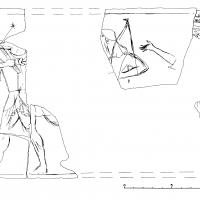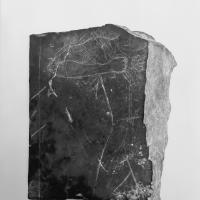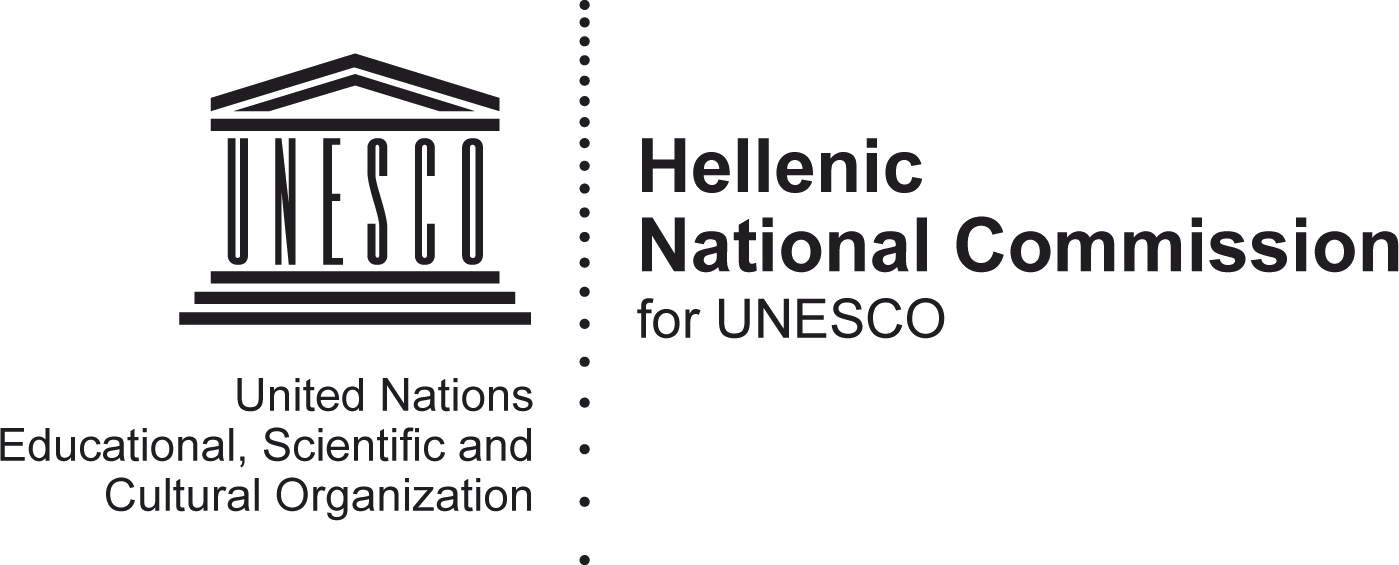Stone panel with scene of contest between Heracles and Apollo
Comment
The fragments of the panel, which probably served a decorative purpose, were found in Hall 73 (fr. 1, 3a-b, 4a-b, 5) and Court 29 (fr. 2) of the Treasury building, within the Achaemenid palatial complex at Persepolis. The earliest identified of the seven fragments (fr. 2) was lost during World War II, when the ship that transported it to the United States was sunk. The remainder of the fragments, now at Persepolis, were identified at a later time by Giuseppe Tilia; the reconstruction of the panel is owed to Michael Roaf. (See Schmidt 1953: 5, 196; idem 1957: 67-68, 155 PT6 595, pl. 31.2; Roaf and Boardman 1980: 204, figs. 1 and 2 [Roaf]; cf. Farkas 1974: 92-93.)
The finely sketched design was presumably meant to serve as a guide for painting the scene (Roaf and Boardman 1980: 204 and n. 7 [Roaf]). The figure of Heracles (left), wearing a lionskin and carrying a club and a quiver, was earlier recognized by Gisela Richter on the fragment known at the time of Erich Schmidt's publications. As interpreted by John Boardman, the scene on the reconstructed panel ought to depict a theme that is at home in archaic Greek mythology and art: a contest between Apollo and Heracles over the Delphic tripod, with 'Heracles escaping left, probably with Apollo's tripod (missing), while Apollo restrains him, with his sister Artemis wearing a polos crown backing him at the right'. Parallels for the panel's iconographic details in late archaic Attic vase painting, elements of anatomy, and style of dress allow a dating of ca. 500 BC. Use in this instance of the dark gray limestone common at the site, speaks for the panel's manufacture locally and the participation of a Greek artist in the decoration of the Persepolitan palaces. Since similar panel paintings were presumably commonly made in wood in late archaic Greece, the Greek artist of the Persepolis stone panel may have been influenced, as Boardman suggested, by local trends of applying painted decoration on stone. (See Schmidt 1957: 67 [Richter]; Roaf and Boardman 1980: 204-206 [Boardman]; Boardman 2000: 132, 133 fig. 4.4.)
Might one consider, with Boardman (2000:132), that a Persian looking at the scene could have perhaps perceived 'the bowman Apollo [as] a royal Persian ..., backed by the goddess Anahita with Persian-seeming crown, dealing with yet another foreigner or barbaric aspect'?
Bibliography
Boardman, J. 2000. Persia and the West: An Archaeological Investigation of the Genesis of Achaemenid Persian Art. New York.
Farkas, A. E. 1974. Achaemenid Sculpture. Leiden.
Roaf, M. and Boardman, J. 1980. 'A Greek painting at Persepolis.' Journal of Hellenic Studies 100: 204-206.
Schmidt, E. F. 1953. Persepolis, vol. I: Structures, Reliefs, Inscriptions. Oriental Institute Publications 68. Chicago. Also available online at https://oi.uchicago.edu/research/publications/oip/oip-68-persepolis-i-structures-reliefs-inscriptions
——. 1957. Persepolis, vol. II: Contents of the Treasury and Other Discoveries, with contributions by S. P. Noe et al., F. R. Matson, L. J. Howell and L. Bellinger. Oriental Institute Publications 69. Chicago. Also available online at https://oi.uchicago.edu/research/publications/oip/oip-69-persepolis-ii-contents-treasury-and-other-discoveries
Cite this entry:
Zournatzi, A. 2016. 'Pārseh (Persepolis): Stone panel with scene of contest between Heracles and Apollo.' In Mapping Ancient Cultural Encounters: Greeks in Iran ca. 550 BC - ca. AD 650. Online edition, preliminary draft release. Available at http://iranohellenica.eie.gr/content/catalogue/parseh-persepolis/documents/takt-e-jamsid/1247549110






Seven fragments of a limestone panel decorated with a scene of contest between Heracles and Apollo. 'Treasury' building, Taḵt-e Jamšid (lit. 'Throne of Jamšid'). Pārseh (Persepolis), Fārs province, Iran. Ca. 500 BC. Excavations of E. F. Schmidt (Oriental Institute of the University of Chicago), 1935-1939. Frgs. 1, 3a-b, 4a-b, 5 in storage on site. Max. surviving dimensions: H. 0,18 m, W. 0.38 m, Th. 0.03-0.035 m.